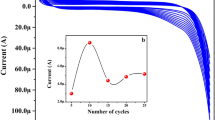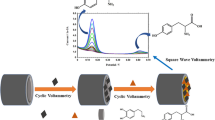Abstract
Through layer-by-layer adsorption (LBL) technique, the positively charged multiwalled carbon nanotubes (MWCNTs) and negatively charged graphene multilayer film were formed on graphite-poly(diallyldimethylammoniumchloride)-polystyrenesulphonate (Gr/PDDA/PSS) modified electrode. Due to large surface area and remarkable electrocatalytic properties of MWCNTs and graphene, the Gr/(PDDA/PSS-[MWCNTs-NH +3 -graphene-COO−]5) electrode exhibits potent electrocatalytic activity towards the electro-oxidation of nicotinamide adenine dinucleotide (NADH). A substantial decrease in the overpotential was observed at modified electrode, and the electrode showed high sensitivity to the electrocatalytic oxidation of NADH. The modified electrode was characterized by cyclic voltammetry and electrochemical impedance spectroscopy. The diffusion coefficient was calculated by chronocoulometry. Chronoamperometric studies showed the linear relationship between oxidation peak current and the concentration of NADH in the range 25–250 μM (R = 0.999) with the detection limit of 0.1 μM (S/N = 3). Further, dopamine, uric acid, acetaminophen and hydrogen peroxide do not interfere in the detection of NADH. The ability of MWCNTs and graphene to promote the electron transfer between NADH and the electrode exhibits a promising biocompatible platform for development of dehydrogenase-based amperometric biosensors. Alcohol dehydrogenase (ADH) was casted on Gr/(PDDA/PSS-[MWCNTs-NH +3 -graphene-COO−]5) electrode; the resulting biosensor showed rapid and high sensitive amperometric response to ethanol with the detection limit of 10 μM (S/N = 3).










Similar content being viewed by others
References
Radoi A, Compagone D (2009) Recent advances in NADH electrochemical sensing design. Bioelectrochemistry 76:126–134
Ge B, Tan Y, Xie Q, Ma M, Yao S (2009) Preparation of chitosan-dopamine-multiwalled carbon nanotubes nanocomposite for electrocatalytic oxidation and sensitive electroanalysis of NADH. Sensors Actuator B 137:547–554
Maroneze CM, Arenas LT, Luz RCS, Benvenutti EV, Landers R, Gushikem Y (2008) Meldola blue immobilized on a new SiO2/TiO2/Graphite composite for electrocatalytic oxidation of NADH. Electrochim Acta 53:4167–4175
Vasilescu A, Andreescu S, Bala C, Litescu SC, Noguer T, Marty JL (2003) Screen-printed electrodes with electropolymerized meldola blue as versatile detectors in biosensors. Biosens Bioelectron 18:781–790
Gurban AM, Noguer T, Bala C, Rotariu L (2008) Improvement of NADH detection using prussian blue modified screen-printed electrodes and different strategies of immobilization. Sensors Actuators B 128:536–544
Ramesh P, Sivakumar P, Sampath S (2003) Phenoxazine functionalized exfoliated graphite based electrodes for NADH oxidation and ethanol biosensing. Electroanalysis 15:1850–1858
Gligor D, Dilgin Y, Popescu LC, Gorton L (2009) Poly-phenothiazine derivative modified glassy carbon electrode for NADH electrocatalytic oxidation. Electrochim Acta 54:3124–3128
Ogino Y, Takagi K, Kano K, Ikeda T (1995) Reactions between diaphorase and quinone compounds in bioelectrocatalytic redox reactions of NADH and NAD+. J Electroanal Chem 396:517–524
Ramesh P, Sampath S (2000) A binderless, bulk –modified, renewable surface amperometric sensor for NADH and ethanol. Anal Chem 72:3369–3373
Matsue T, Suda M, Uchida I (1987) Electrocatalytic oxidation of NADH by ferrocene derivatives and the influence of cyclodextrin complexation. J Electroanal Chem 234:163–173
Serban S, Murr NE (2004) Synergetic effect for NADH oxidation of ferrocene and zeolite in modified carbon paste electrodes. New approach for dehydrogenase based biosensors. Biosens Bioelectron 20:161–166
Silva FDADS, Lopes CB, Costa EDO, Lima PR, Kubota LT, Oliveria M, Goulart F (2010) Poly-xanthurenic acid as an efficient mediator for the electrocatalytic oxidation of NADH. Electrochem Commun 12:450–454
Mu S, Zhang Y, Zhai J (2009) Electrocatalysis of NADH oxidation by nanostructured Poly(aniline-co-2-amino-4-hydroxybenzenesulphonic acid) and experimental evidence for the catalytic mechanism. Electrochem Commun 11:1960–1963
Balamurugan A, Chen SM (2008) Voltammetric oxidation of NADH at phenyl azo aniline/PEDOT modified electrode. Sensors Actuators B 129:850–858
Manesh KM, Santosh P, Gopalan A, Lee KP (2008) Electrocatalytic oxidation of NADH at gold nanoparticles loaded poly(3,4-ethylenedioxythiophene)-poly(styrene sulfonic acid) film modified electrode and integration of alcohol dehydrogenase for alcohol sensing. Talanta 75:1307–1314
Mano N, Kuhn A (1999) Immobilized nitro-fluorenone derivatives as electrocatalysts for NADH oxidation. J Electroanal Chem 477:79–88
Mano N, Kuhn A (1999) Ca2+ enhanced electrocatalytic oxidation of NADH by immobilized nitro-flurenones. Electrochem Commun 1:497–501
Banks C, Compton RG (2005) Exploring the electrocatalytic sites of carbon nanotubes for NADH detection: an edge plane pyrolytic graphite electrode study. Analyst 130:1232–1239
Wooten M, Gorski W (2010) Facilitation of NADH electro-oxidation at treated carbon nanotubes. Anal Chem 82:1299–1304
Yang DW, Liu HH (2009) Poly(brilliant cresyl blue)-carbon nanotubes modified electrodes for determination of NADH and fabrication of ethanol dehydrogenase-based biosensor. Biosens Bioelectron 25:733–738
Luz RDCS, Damos FS, Tanaka AA, Kuboto LT, Gushikem Y (2008) Electrocatalytic activity of 2, 3, 5, 6-tetrachloro-1, 4-benzoquinone/multi-walled carbon nanotubes immobilized on edge plane pyrolitic graphite electrode for NADH oxidation. Electrochim Acta 53:4706–4714
Wang Y, Li Y, Tang L, Lu J, Li J (2009) Application of graphene-modified electrode for selective detection of dopamine. Electrochem Commun 11:889–892
Shan C, Yang H, Han D, Zhang Q, Ivaska A, Niu L (2010) Electrochemical determination of NADH and ethanol based on ionic liquid-functionalized graphene. Biosens Bioelectron 25:1504–1508
Kang XH, Wang J, Wu H, Aksay I, Liu J, Lin Y (2009) Glucose oxidase-graphene-chitosan modified electrode for direct electrochemistry and glucose sensing. Biosens Bioelectron 25:901–905
Shan C, Yang H, Han D, Zhang Q, Ivaska A, Niu L (2010) Graphene/ AuNPs/ chitosan nanocomposite film for glucose biosensing. Biosens Bioelectron 25:1070–1074
Zheng H, Okada H, Nojima S, Suye SI, Hori T (2004) Layer-by-layer assembly of enzymes and polymerized mediator on electrode surface by electrostatic adsorption. Sci Technol Adv Mater 5:371–376
Nethravathi C, Rajamathi M (2008) Chemically modified graphene sheets produced by the solvothermal reduction of colloidal dispersion of graphite oxide. Carbon 46:1994–1998
Su CY, Xu Y, Zhang W, Zhao J, Liu A, Tang X, Tsai CH, Huang Y, Li LJ (2010) Highly efficient restoration of graphitic structure in graphene oxide using alcohol vapors. ACS Nano 4:5285–5292
Gilje S, Han S, Wang M, Wang KL, Kaner RB (2007) A chemical route to graphene for device applications. Nano Lett 7:3394–3398
Prasanna Kumar S, Manjunatha R, Nethravathi C, Suresh GS, Rajamathi M, Venkatesha TV (2011) Electrocatalytic oxidation of NADH on functionalized graphene modified graphite electrode. Electroanalysis 23:842–849
Woo Lee S, Kim BS, Chen S, Shao-Horn Y, Hammond PT (2009) Layer-by-Layer assembly of all carbon nanotube ultrathin films for electrochemical applications. J Am Chem Soc 131:671–679
Huang KJ, Niu DJ, Sun JY, Han CH, Wu ZW, Li YL, Xiong XQ (2011) Novel electrochemical sensor based on functinalized graphene for simultaneous determination of adenine and guanine in DNA. Colloids Surf B Biointerfaces 82:543–549
Liu A, Wei M, Honma I, Zhou H (2006) Biosensing properties of titanate-nanotube films: selective detection of dopamine in the presence of ascorbate and uric acid. Adv Funct Mater 16:371–376
Meng L, Wu P, Chen G, Cai C, Sun Y, Yuan Z (2009) Low potential detection of glutamate based on the electrocatalytic oxidation of NADH at thionine/single-walled carbon nanotubes composite modified electrode. Biosens Bioelectron 24:1751–1756
Zeng J, Wei W, Wu L, Liu X, Liu K, Li Y (2006) Fabrication of poly(toluidine blue O)/Carbon Nanotube composite nanowires and its stable low-potential detection of NADH. J Electroanal Chem 595:152–160
Jensen MA, Elving PJ (1978) Oxidation of l, 4 NADH at a glassy carbon electrode: Effects of pH, lewis acids and adsorption. Bioelectrochem Bioenerg 5:526–534
Prieto-Simon B, Fabregas E (2006) New redox mediator-modified polysulfone composite films for the development of dehydrogenase-based biosensors. Biosens Bioelectron 22:131–137
Li M, Jing L (2007) Electrochemical behavior of acetaminophen and its detection on the PANI-MWCNTs composite modified electrode. Electrochim Acta 52:3250–3257
Wang C, Li C, Wang F, Wang C (2006) Covalent modification of glassy carbon electrode with L-Cysteine for the determination of acetoaminophen. Microchim Acta 155:365–371
Yang M, Qu F, Li Y, He Y, Shen G, Yu R (2007) Direct electrochemistry of hemoglobin in gold nanowire array. Biosens Bioelectron 23:414–420
Deng C, Chen J, Chen X, Xiao C, Nie Z, Yao S (2008) Boron-doped carbon nanotubes modified electrode for electroanalysis of NADH. Electrochem Commun 10:907–909
Salami A, Hallaj R, Ghadermazi M (2005) Modification of carbon ceramic electrode prepared with sol-gel technique by thin film of chlorogenic acid: application to amperometric detection of NADH. Talanta 65:888–894
Dai Z, Lu G, Bao J, Huang X, Huangxian (2007) Low potential detection of NADH at titanium-containing MCM-41 modified glassy carbon electrode. Electroanalysis 19:604–607
Rao TN, Yagi I, Miwa T, Tryk DA, Fujishima A (1999) Electrochemical oxidation of NADH at highly boron-doped diamond electrodes. Anal Chem 71:2506–2511
Yemini M, Reches M, Gazit E, Rishpon J (2005) Peptide nanotube-modified electrodes for enzyme-biosensor applications. Anal Chem 77:5155–5159
Vasantha VS, Chen SM (2006) Synergistic effect of catechin-immobilized poly (3,4- ethylenedioxythiophene)-modified electrode on electrocatalysis of NADH in the presence of ascorbic acid and uric acid. Electrochim Acta 52:665–674
Pariente F, Tobalina F, Moreno G, Hernandez L, Lorenzo E, Abruna HD (1997) Mechanistic studies of the electrocatalytic oxidation of NADH and ascorbate at glassy carbon electrodes modified with electrodeposited films derived from 3, 4- dihydroxybenzaldehyde. Anal Chem 69:4065–4075
Acknowledgments
The authors gratefully thank Sri. A.V.S. Murthy, honorary secretary of Rashtreeya Sikshana Samiti Trust, Bangalore and Dr. P. Yashoda, Principal, S.S.M.R.V. Degree College, Bangalore for their continuous support and encouragement. S. Prasanna Kumar personally thank Fr. Roshan Lobo, Principal, St. Joseph’s Pre-University College, Bangalore for his support and encouragement.
Author information
Authors and Affiliations
Corresponding author
Rights and permissions
About this article
Cite this article
Prasannakumar, S., Manjunatha, R., Nethravathi, C. et al. Graphene-carbon nanotubes modified graphite electrode for the determination of nicotinamide adenine dinucleotide and fabrication of alcohol biosensor. J Solid State Electrochem 16, 3189–3199 (2012). https://doi.org/10.1007/s10008-012-1754-z
Received:
Revised:
Accepted:
Published:
Issue Date:
DOI: https://doi.org/10.1007/s10008-012-1754-z




